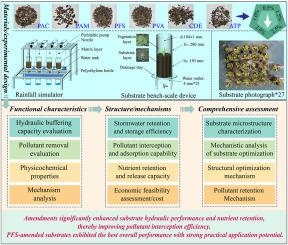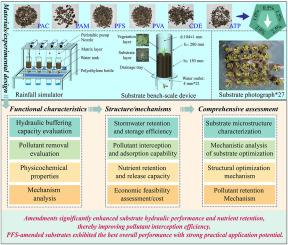系统实验和多标准评估框架,以验证修正-增强团聚基质层用于绿色屋顶雨水和污染物控制
IF 10
1区 环境科学与生态学
Q1 ENGINEERING, ENVIRONMENTAL
引用次数: 0
摘要
在水敏感型城市设计中,污染物去除和水文调节的低能耗策略越来越重要。作为绿化屋顶的关键组成部分,基材层在径流截留、污染物截留和养分保存等方面发挥着重要作用,但缺乏系统层面的全面研究。本研究建立了一个综合的“材料-结构-功能-评价”框架,结合系统实验和多维建模,阐明了六种类型的修正(27种测试组合)增强聚合结构以改善水文性能、减少污染物和营养保留的协同机制。为支持绿色屋顶基材的可持续应用,建立了标准化的评价流程和综合指标体系。结果表明,改性剂显著改善了基质的水力性能。改良基质通过调节粒径分布、改善孔隙结构和形成多尺度团聚体来增强径流减少。修正还减少了降雨引起的养分淋溶,增强了养分滞留,促进了NH4+-N和TP的积累,从而提高了污染物拦截效率。所有改性底物均提高了TN和TP的去除率,其中聚合硫酸铁(PFS)的去除率最高(TN: 23.13%, TP: 82.93%)。PFS通过化学沉淀和物理滞留相结合的方式减少了总磷和硝酸盐的浸出,同时保持了磷的有效性并改善了出水质量。从PFS中释放出的Fe3+与PO43−形成不溶性配合物,有效地限制了氮和磷通过径流迁移。一项加权综合评估证实,所有的改性都增强了基质的多功能性,其中pfs改性的基质在水文调节、污染控制和养分保留方面表现出最佳性能,显示出强大的实际应用潜力。本文章由计算机程序翻译,如有差异,请以英文原文为准。


Systematic experiments and a multi-criteria assessment framework to validate amendments-enhanced agglomerated matrix layer for green roof stormwater and pollutant control
Low-energy strategies for pollutant removal and hydrological regulation are increasingly critical in water-sensitive urban design. As a key component of green roofs, the substrate layer plays a vital role in runoff retention, pollutant interception, and nutrient conservation, yet lacks a comprehensive system-level investigation. This study developed an integrated "material–structure–function–evaluation" framework, combining systematic experiments and multidimensional modeling to elucidate the synergistic mechanisms by which six types of amendments (27 tested combinations) enhance aggregate structure for improved hydrological performance, pollutant reduction, and nutrient retention. A standardized evaluation process and comprehensive index system were established to support the sustainable application of green roof substrates. Results showed that the amendments significantly improved the substrates' hydraulic properties. Modified substrates enhanced runoff reduction by regulating particle size distribution, improving pore structure, and forming multiscale aggregates. The amendments also reduced rainfall-induced nutrient leaching, enhanced nutrient retention, and promoted the accumulation of NH4+-N and TP, thereby improving pollutant interception efficiency. All amended substrates improved TN and TP removal, with polyferric sulfate (PFS) showing the highest efficiency (TN: 23.13 %, TP: 82.93 %). PFS reduced TP and nitrate leaching through combined chemical precipitation and physical retention, while maintaining phosphorus availability and improving effluent quality. Released Fe3+ from PFS formed insoluble complexes with PO43−, effectively limiting nitrogen and phosphorus migration via runoff. A weighted comprehensive evaluation confirmed that all amendments enhanced substrate multifunctionality, with PFS-modified substrates demonstrating optimal performance in hydrological regulation, pollution control, and nutrient retention, indicating strong potential for practical application.
求助全文
通过发布文献求助,成功后即可免费获取论文全文。
去求助
来源期刊

Journal of Cleaner Production
环境科学-工程:环境
CiteScore
20.40
自引率
9.00%
发文量
4720
审稿时长
111 days
期刊介绍:
The Journal of Cleaner Production is an international, transdisciplinary journal that addresses and discusses theoretical and practical Cleaner Production, Environmental, and Sustainability issues. It aims to help societies become more sustainable by focusing on the concept of 'Cleaner Production', which aims at preventing waste production and increasing efficiencies in energy, water, resources, and human capital use. The journal serves as a platform for corporations, governments, education institutions, regions, and societies to engage in discussions and research related to Cleaner Production, environmental, and sustainability practices.
 求助内容:
求助内容: 应助结果提醒方式:
应助结果提醒方式:


